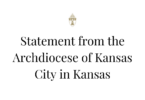
Photo by Rose Hammes
The challenge of pastoral planning for the second-largest region in the archdiocese required a great deal of thought and planning. Father Jerry Williams, O. Carm. (left), and Father Anthony Williams, regional pastoral leader, were among the clergy and laity who hammered out a plan that has collaboration and communication as key components.
by Joe Bollig
joe@theleaven.org
KANSAS CITY, Kan. — The size of the Southern Pastoral Region played a big role in shaping the regional pastoral plan now being put into effect.
The Southern Region encompasses 18 parishes — the same number as the Johnson County Pastoral Region, which is much smaller geographically. For comparison’s sake, the Southern Region covers 3,701 square miles, while the Johnson County Region covers only 366.
In the latter region, to take another example, a drive from the two parishes most distant from each other is only 28 miles. In the Southern Region, it is 97 miles.
This kind of geography is why two of the major components of the Southern Region pastoral plan are collaboration among parishes and clustering.
“Collaboration is key in assisting in the renewal of the vitality of parishes,” said Father Anthony Williams, pastor of St. Joseph Parish in Olpe and St. Mary Parish in Hartford. He is also the regional pastoral leader.
“The question is: How can we best utilize our resources for growth and service to our parishioners?” Father Williams continued. “Establishing parishes in different clusters is one way to maximize our resources and to facilitate communication.”
The Southern Region pastoral plan presents a common vision for parishes and schools in the region.
The 28-page plan also calls for the 18 parishes and five schools of the region (plus the Didde Catholic Center at Emporia State) to strive for eight shared goals and targets. Among the eight are additional opportunities for adult faith formation, assisting the youth to grow spiritually, and identifying opportunities for collaboration.
Given the diversity of the parishes and the expanse of the region, the plan is further broken down into specific recommendations for each parish.
Collaboration is vital for the Southern Region, said Alan Meitler, a planning consultant for the Milwaukee-based Meitler Consultants.
“It can be difficult for a small parish to provide full, complete ministries on its own,” he said. “That’s why [participants] looked at the ways parishes work together. It might be informal, or clustering, or maybe eventually merging.”
For collaboration to work, according to Meitler, Catholics need to see themselves as a community that is not defined solely by the church building where they worship, but by a larger community that can join hands across parish boundaries for more effective ministry.
One example of this is Catholic education in the region. Often, the five schools draw students from beyond the parish boundaries.
“Catholic schools may be parish-owned from an administrative point of view but, from a mission point of view, they serve a larger geography than that particular parish,” said Meitler. “Often, they will serve other parishes in the surrounding area. Those schools need the support of people in those broader areas.”
Recommendations contained in the plan call for:
1. Creating parish clusters for collaboration
2. Requesting continued assistance from the Carmelite order
3. Improving marketing and recruitment efforts for Catholic schools
4. Developing strategic plans for Catholic schools that encompass accreditation, advancement, marketing, recruitment, financial plans and facility plans
5. Conducting programs at convenient locations within the region and use technology to give training to people who find long distances a barrier
6. Making more resources and tools available to volunteers
7. Establishing a pilot program at one parish for remote catechetical training, possibly Web-based
8. Using computer-based backup systems to safeguard parish records.
Demographics are a challenge in the region. Some parish populations are growing, while others are holding their own, according to Father Williams. Some schools have lost enrollment.
Another important demographic element is the number of priests in the region. Now there are 12 priests there — 11 archdiocesan, and one a member of the Carmelite religious order. The pastoral plan, in Appendix B, outlines possible options if those numbers decrease.
“While this is not a desirable situation, a planned response will be better than being surprised and forced to make sudden changes,” according to the plan.
For a copy of the Southern Region pastoral plan, go to the archdiocesan Web site at: www.archkck.org. There, “The Archdiocese” tab provides a pull-down menu; click on “pastoral planning.” Pastoral plans for the various archdiocesan regions are all located there.






